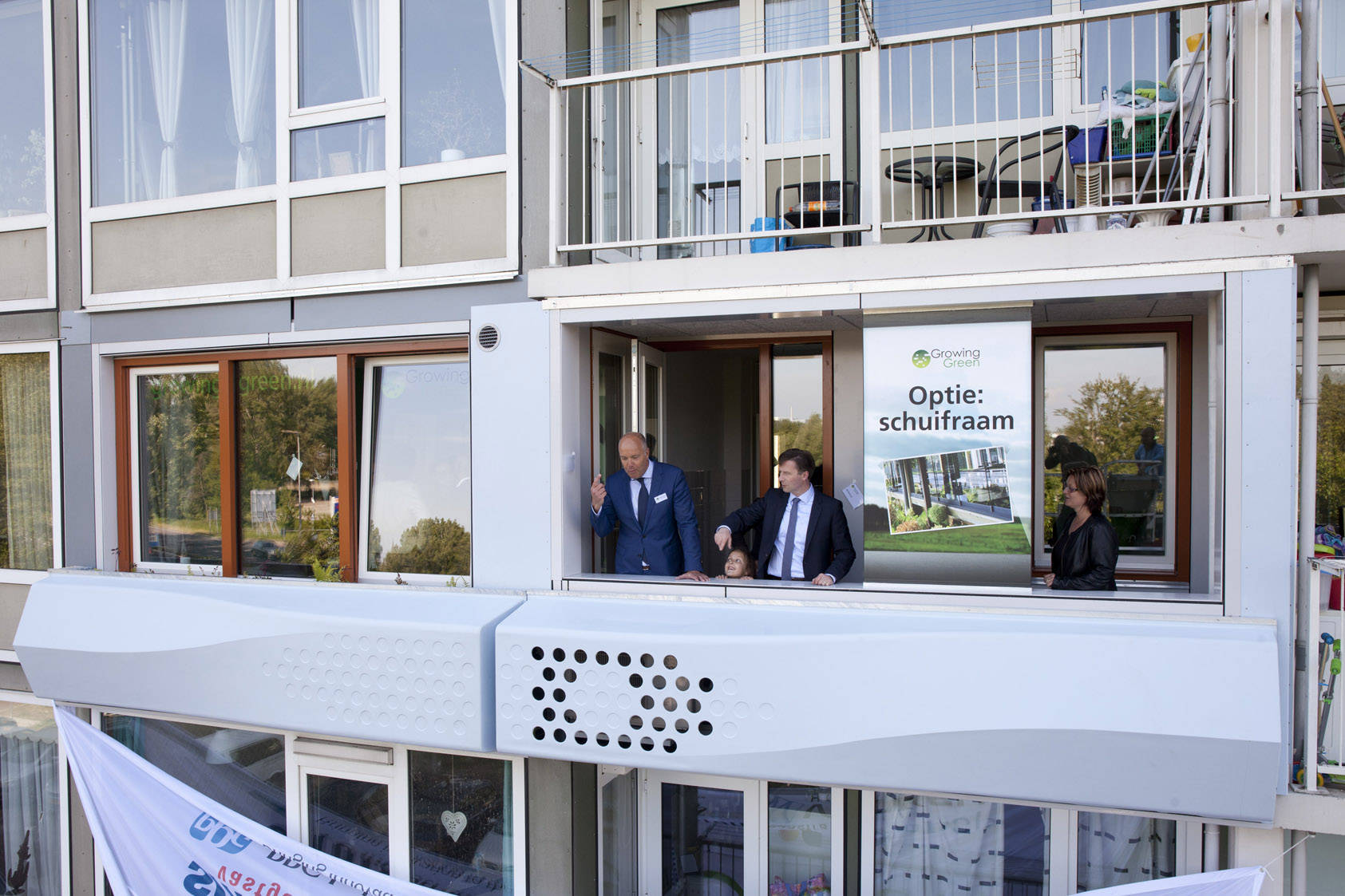At the end of May, an innovative flax fibre outer wall component according to the Growing Green concept (see box) was installed in the first housing unit of housing corporation Woonbron in Delft. This apartment has high-quality insulated outer walls and new wooden window frames with triple glass. An air/water heat pump is ‘hung’ on the outside of the apartment in an outer wall component of flax fibre reinforced biocomposite. The air-heat pump is integrated in this. It also includes a flower box, because appearance is also important.
The advantages of flax fibre instead of glass fibre and biobased resin instead of petroleum-based resin in composites are evident: a low CO2 footprint, the material is strong and rigid and still light-weight. Moreover, it can be shaped into any form. The biocomposite also absorbs noise and vibrations well: the noise of the water pump is absorbed better, as shown by TNO studies. The energy costs to the residents drop considerably because of this adaptation in each apartment. And that is certainly a bonus in times of rent increases.
Time for a change
The idea of using flax fibre was developed by Zeeland-Brabant consortium Glowing Green. Initiator is Smits Vastgoedzorg in Rotterdam, which advises home owners such as housing corporations in renovation of the housing stock.
‘Because of the crisis in construction, since 2012 we have been putting our efforts into development of innovation in products and materials,’ according to Smits Vastgoedzorg’s developer Christian van Gruijthuijsen. ‘It is time for a change for housing managers such as housing corporations and owner associations. Large new construction projects are ever more often being replaced by rebuilding and renovation. Meanwhile, housing corporations must adapt their housing units as a result of new legislation, sustainability ambitions, and changes in living requirements. This often demands big investments that cannot always be realised. A customised solution is often a better option in that case.’
The big advantage of Growing Green is that not all housing units in a complex need to be renovated at the same time. The units can be adapted in phases, for example when there is a change in residents in a unit. Moreover the renovation only takes five days, which will keep the nuisance to the tenant to a minimum.
‘We took this plan to housing corporation Woonbron. They made two housing units available so we could experiment with them. This eventually resulted in the first apartment according to the Growing Green concept.
How did Smits Vastgoed come to use flax fibre as a material for renovation in construction? ‘We were looking for a suitable and sustainable material. Concrete slabs were rejected because of their weight, while polyester is unsustainable. Thus we eventually ended up with flax, a natural material which is actually being grown nearly right around the corner at Van de Bilt!’
Believing in innovation
Lenno Vermaas of flax fibre producer Van de Bilt is enthusiastic about this innovation. It is one of the few flax companies that has an integrated production from breeding through processing and commerce of short and long fibres and seeds.
Vermaas: ‘Van de Bilt has already been working on innovative applications for years. Which is why we were happy to join the consortium. We are convinced this concept has a future. But we are not there yet. Traditionally, the great majority of the flax goes to the textile market and 10 percent goes to non-textile. For example, flax fibres are used in building insulation, expensive design chairs, sports articles, car parts. But then you are not talking about the large quantities yet. The non-textile share will be growing in the years to come, I am convinced of that. We still do not know exactly how high this share will be, as a concept like Growing Green is still too new for this. It is important that we and our growers let go of our scepticism and keep believing in innovations.’
The power of working together
Vermaas believes in the power of working together to realise complex concepts à la Glowing Green. Specialists that complement each other well. ‘We would scarcely be able to launch such a complex concept by ourselves as our chain runs up to semi-finished products. We are not going to build houses or renovate them, as other companies can do that much better. We need partners who add value.’
Meanwhile the grower still sees little evidence of the application of flax in new markets, as the quantities are too low for that as yet. However, that will change if bigger sectors such as construction head more towards biobased. ‘The world of construction is in the process of embracing biobased. And if the consumer starts accepting this as well, we will have taken another step forward.’
In any case, the reactions have been very positive to date. ‘Motor coaches filled with housing corporation management visit to look at the renovated housing unit. A delegation from Sweden is even expected soon,’ says Van Gruijthuijsen. ‘Thus the next step is that we want to renovate more housing units according to this concept. Approximately four percent of all housing units in our country consists of clustered housing units. This involves a total of 300,000 homes. If our consortium were to renovate one percent of this…’
The time has not yet come, but the spirit of the age is ready for it in any event, according to Van Gruijthuijsen. ‘There are still plenty of hurdles. Municipalities are positive, but issuing a permit still takes too long. The price also has to drop: the renovation according to our concept currently costs 70,000 euros, which we need to reduce to about 50,000 euros.



